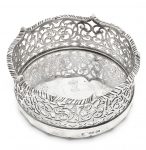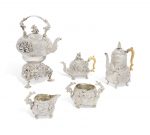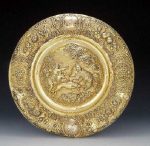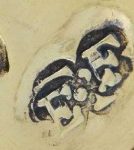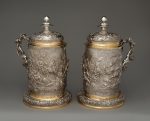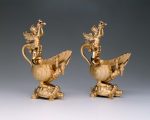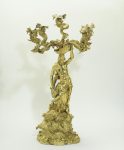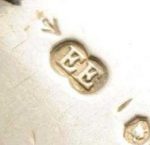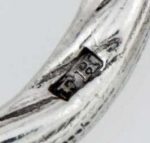Edward Farrell was born in 1779 and died in 1850. He was renown for his exquisite and elaborate chased designs in the Renaissance style. He was also silversmith and jeweller to HRH The Duke of York.
A Victorian silver wine coaster by Edward Farrell, London 1837 With a pierced rim and wood-mounted base, diameter 15cm.
Sold for £ 500 inc. premium at Bonhams in 2018
A GEORGE IV FIVE-PIECE SILVER TEA AND COFFEE-SERVICE MARK OF EDWARD FARRELL, LONDON, 1821, THE KETTLE AND STAND 1822 Pear-shaped, cast, chased in high relief and applied with figures in taverns or rural landscapes and on crouching figures or lion-mask capped paw feet, comprising: a teapot; a coffee-pot, each with figure finial on barrel above oak leaf and acorn calyx, with carved ivory handle; a kettle and stand, the overhead swing handle cast with figures and with figure finial; a cream-jug and a sugar bowl, marked near handles, the teapot and coffee-pot further marked on cover and finial, the kettle further marked on stand, handle, cover bezel and finial the kettle and stand 16 ¼ in. (41.2 cm.) high gross weight 227 oz. 14 dwt. (7,082 gr.)
Sold for GBP 20,000 at Christies in 2018
An early Victorian silver gilt circular sideboard dish or plaque by Edward Farrell, London 1838, the centre embossed with dogs attacking an animal, two figures looking on, perhaps the Death of Actaeon, the broad rim with panels of fruit and flowers, shells, scroll foliage, three later crests and an armorial, 50cm (19 1/2in) diameter, 1727g (55.5 oz)The crests and arms for ANSTRUTHER-GOUGH-CALTHORPE. The baronetcy was created in 1929 for Sir Fitzroy Hamilton Niall ANSTRUTHER-GOUGH-CALTHORPE (1872-1957). He adopted this surname 1910 (it had previously been LLOYD-ANSTRUTHER) after his marriage in 1898 to the Hon. Rachel GOUGH-CALTHORPE (1871-1951). The armorial contains no baronets coronet and as the arms are quartered and not impaled we would expect that the arms in the image to be those of his son and heir Sir Richard ANSTRUTHER-GOUGH-CALTHORPE (1908-1985), of Elvetham Hall in Elvetham, Hants., before his father’s death in 1929. The arms are confirmed by Burke’s Peerage.
Sold for £3,000 at Dreweatts Donnington Priory in 2018
Edward Farrell Silver Makers Mark
Silversmith:Edward Farrell (British, 1779–1850) Silversmith: Finials made by Charles Frederick Hancock (British, born 1807) Retailer:Probably retailed by Kensington Lewis (British, 1790–1854) Date:1824–25
This pair of tankards if an outstanding example of the daring, eclectic historicism that was a specialty of the London silversmith Edward Farrell who collaborated with Kensington Lewis, a retailer. Farrell’s work is characterized by boldly chased and cast decoration inspired by Renaissance, Baroque and Rococo designs. Lewis supplied silver to many patrons in the circle of the Prince Regent, but it was famously Prince Frederick Augustus, Duke of York who was his most voracious client.
Reference: The Metropolitan Museum of Art
Salts English (London) 1824–25 Marked by Edward Farrell (English, registered in 1813)
Each salt is composed of a spiral shell with a fluted lip on clawed legs. Beneath the lip of the salt is a bearded, turbaned demifigure. The whole rests on a base formed of a tortoise. The handle is formed from the serpent’s tail of a fantastic winged creature who perches, as the thumbpiece of the salt, blowing a conch shell. The salt is assembled from heavily cast components, richly chased and thickly gilt. Inscription ARMORIALS: engraved on the lip of both salts to the right of the handle, the Royal crest with the Garter motto and surmounted by a Royal coronet, presumably for the Duke of York. Markings To left of handle, liopn passant; leopard’s head; date letter i; sovereign’s head; maker’s mark EF.
Reference: Museum of Fine Arts Boston
An impressive George IV silver tea urn, Edward Farrell probably retailed by Kensington Lewis, London, 1821 the oviform body cast and embossed in very high relief with battle landscape and architectural scenes on a heavy cast and pierced base and lion mask and claw feet the spigot cast as a youthful Bacchus sitting on an ivory barrel, 50.8cm., 20in., high 5853gr., 188oz., 4dwt.
Sold for 37,500 GBP at Sothebys in 2017
Silver gilt four branched candelabrum formed by the figure of Neptune astride a hippocamp on a rocky base holding the candelabrum branches in the form of a four winged hydra springing forth from a shell.
This magnificent candelabrum has been modelled with a figure of Neptune (Roman god of the sea) part kneeling on a sea horse or hippocamp, on a rocky base cast and chased with shells, seaweed and sea creatures. Neptune has a trident in his left hand and supports with his right a shell from which a hydra (mythical many headed snake) springs to form the branches to hold candles. The candelabrum was part of a massive table garniture ordered by the Duke of York. In the catalogue of the sale of the Duke of York’s silver in 1827 the candelabrum is attributed to the antiquarian and silver retailer Kensington Lewis, whose trade card proudly describes him as ‘Silversmith and Jeweller to his R. H. the Duke of York’. Lewis purchased the candelabrum back at the sale for £180 13s 4d. The Duke of York did not buy exclusively from Lewis; other candelabra made for the Duke have the mark of Paul Storr, a partner in the workshop of the Royal Goldsmiths, Rundell, Bridge and Rundell, who were one of the major creditors left unpaid after the Duke’s death. This candelabrum is marked for Edward Farrell, a silversmith who worked in association with Kensington Lewis between about 1816 until the mid-1830s. The Duke of York was Lewis’ most important patron and his business suffered after the Duke’s death. The candelabrum could have been made by Farrell and sold to the Duke of York by Lewis, but the contribution of the silversmith and retailer in the design is uncertain. It is curious that the silver that Farrell made after the Duke’s death shows no sign of the ambition of this piece. Did Kensington Lewis, through his interest in antiquarian silver provide the stylistic input, or was there an as yet unidentified modeller who provided the designs for the Duke of York’s most inventive silver?
Reference: © Victoria and Albert Museum
